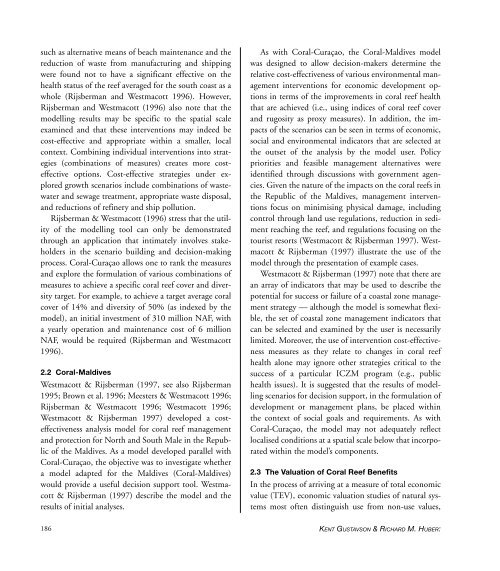You also want an ePaper? Increase the reach of your titles
YUMPU automatically turns print PDFs into web optimized ePapers that Google loves.
such as alternative means <strong>of</strong> beach maintenance and the<br />
reduction <strong>of</strong> waste from manufacturing and shipping<br />
were found not to have a significant effective on the<br />
health status <strong>of</strong> the reef averaged for the south coast as a<br />
whole (Rijsberman and Westmacott 1996). However,<br />
Rijsberman and Westmacott (1996) also note that the<br />
modelling results may be specific to the spatial scale<br />
examined and that these interventions may indeed be<br />
cost-effective and appropriate within a smaller, local<br />
context. Combining individual interventions into strategies<br />
(combinations <strong>of</strong> measures) creates more costeffective<br />
options. Cost-effective strategies under explored<br />
growth scenarios include combinations <strong>of</strong> wastewater<br />
and sewage treatment, appropriate waste disposal,<br />
and reductions <strong>of</strong> refinery and ship pollution.<br />
Rijsberman & Westmacott (1996) stress that the utility<br />
<strong>of</strong> the modelling tool can only be demonstrated<br />
through an application that intimately involves stakeholders<br />
in the scenario building and decision-making<br />
process. <strong>Coral</strong>-Curaçao allows one to rank the measures<br />
and explore the formulation <strong>of</strong> various combinations <strong>of</strong><br />
measures to achieve a specific coral reef cover and diversity<br />
target. For example, to achieve a target average coral<br />
cover <strong>of</strong> 14% and diversity <strong>of</strong> 50% (as indexed by the<br />
model), an initial investment <strong>of</strong> 310 million NAF, with<br />
a yearly operation and maintenance cost <strong>of</strong> 6 million<br />
NAF, would be required (Rijsberman and Westmacott<br />
1996).<br />
2.2 <strong>Coral</strong>-Maldives<br />
Westmacott & Rijsberman (1997, see also Rijsberman<br />
1995; Brown et al. 1996; Meesters & Westmacott 1996;<br />
Rijsberman & Westmacott 1996; Westmacott 1996;<br />
Westmacott & Rijsberman 1997) developed a costeffectiveness<br />
analysis model for coral reef management<br />
and protection for North and South Male in the Republic<br />
<strong>of</strong> the Maldives. As a model developed parallel with<br />
<strong>Coral</strong>-Curaçao, the objective was to investigate whether<br />
a model adapted for the Maldives (<strong>Coral</strong>-Maldives)<br />
would provide a useful decision support tool. Westmacott<br />
& Rijsberman (1997) describe the model and the<br />
results <strong>of</strong> initial analyses.<br />
As with <strong>Coral</strong>-Curaçao, the <strong>Coral</strong>-Maldives model<br />
was designed to allow decision-makers determine the<br />
relative cost-effectiveness <strong>of</strong> various environmental management<br />
interventions for economic development options<br />
in terms <strong>of</strong> the improvements in coral reef health<br />
that are achieved (i.e., using indices <strong>of</strong> coral reef cover<br />
and rugosity as proxy measures). In addition, the impacts<br />
<strong>of</strong> the scenarios can be seen in terms <strong>of</strong> economic,<br />
social and environmental indicators that are selected at<br />
the outset <strong>of</strong> the analysis by the model user. Policy<br />
priorities and feasible management alternatives were<br />
identified through discussions with government agencies.<br />
Given the nature <strong>of</strong> the impacts on the coral reefs in<br />
the Republic <strong>of</strong> the Maldives, management interventions<br />
focus on minimising physical damage, including<br />
control through land use regulations, reduction in sediment<br />
reaching the reef, and regulations focusing on the<br />
tourist resorts (Westmacott & Rijsberman 1997). Westmacott<br />
& Rijsberman (1997) illustrate the use <strong>of</strong> the<br />
model through the presentation <strong>of</strong> example cases.<br />
Westmacott & Rijsberman (1997) note that there are<br />
an array <strong>of</strong> indicators that may be used to describe the<br />
potential for success or failure <strong>of</strong> a coastal zone management<br />
strategy — although the model is somewhat flexible,<br />
the set <strong>of</strong> coastal zone management indicators that<br />
can be selected and examined by the user is necessarily<br />
limited. Moreover, the use <strong>of</strong> intervention cost-effectiveness<br />
measures as they relate to changes in coral reef<br />
health alone may ignore other strategies critical to the<br />
success <strong>of</strong> a particular ICZM program (e.g., public<br />
health issues). It is suggested that the results <strong>of</strong> modelling<br />
scenarios for decision support, in the formulation <strong>of</strong><br />
development or management plans, be placed within<br />
the context <strong>of</strong> social goals and requirements. As with<br />
<strong>Coral</strong>-Curaçao, the model may not adequately reflect<br />
localised conditions at a spatial scale below that incorporated<br />
within the model’s components.<br />
2.3 The Valuation <strong>of</strong> <strong>Coral</strong> Reef Benefits<br />
In the process <strong>of</strong> arriving at a measure <strong>of</strong> total economic<br />
value (TEV), economic valuation studies <strong>of</strong> natural systems<br />
most <strong>of</strong>ten distinguish use from non-use values,<br />
186<br />
KENT GUSTAVSON & RICHARD M. HUBER:


















